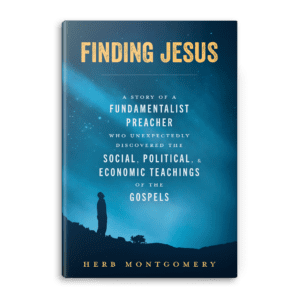
As we wrap up our discussion on Jesus as liberation from systemic injustice, take note of these parallels that Matthew creates to call to mind images of Moses:
Welcome Readers! Please subscribe to Social Jesus Here.
(Read this series from the beginning at Part 1 and Part 2.)
“Then the LORD said to Moses, “Come up to the LORD, you and Aaron, Nadab and Abihu . . .” (Exodus 24:1)
“Jesus took with him Peter, James and John the brother of James, and led them up a high mountain by themselves.” (Matthew 17:1)
“When Moses went up on the mountain, the cloud covered it, and the glory of the LORD settled on Mount Sinai. For six days the cloud covered the mountain, and on the seventh day the LORD called to Moses from within the cloud.” (Exodus 24:15-16)
“After six days Jesus took with him Peter, James and John the brother of James, and led them up a high mountain by themselves.” (Matthew 17:1)
“When Moses came down from Mount Sinai with the two tablets of the covenant law in his hands, he was not aware that his face was radiant because he had spoken with the LORD . . . his face was radiant . . . he put a veil over his face . . . his face was radiant . . .” (Exodus 34:29-35)
“After six days Jesus took with him Peter, James and John the brother of James, and led them up a high mountain by themselves. There he was transfigured before them. His face shone like the sun . . . ” (Matthew 17:1-2)
On the mount of transfiguration Jesus speaks with God face to face. This had only happened for two others in Hebrew folklore: Moses and Elijah.
“Since then, no prophet has risen in Israel like Moses, whom the LORD knew face to face” (Deuteronomy 34:10)
“There he went into a cave and spent the night. And the word of the LORD came to him: “What are you doing here, Elijah?” He replied, “I have been very zealous for the LORD God Almighty. The Israelites have rejected your covenant, torn down your altars, and put your prophets to death with the sword. I am the only one left, and now they are trying to kill me too.” The LORD said, “Go out and stand on the mountain in the presence of the LORD, for the LORD is about to pass by.” Then a great and powerful wind tore the mountains apart and shattered the rocks before the LORD, but the LORD was not in the wind. After the wind there was an earthquake, but the LORD was not in the earthquake. After the earthquake came a fire, but the LORD was not in the fire. And after the fire came a gentle whisper. When Elijah heard it, he pulled his cloak over his face and went out and stood at the mouth of the cave. Then a voice said to him, “What are you doing here, Elijah?” (1 Kings 19:9-13)
Unlike Mark, Matthew repeats the words that were spoken earlier to Jesus at his baptism. This would have reminded Mathew’s audience of a verse in Isaiah:
“Here is my servant, whom I uphold,
my chosen one in whom I delight;
I will put my Spirit on him,
and he will bring justice to the nations.” (Isaiah 42:1)
And lastly, Moses and Elijah were both Hebrew heroes for whom, according to tradition, death did not have the last word.
“As they were walking along and talking together, suddenly a chariot of fire and horses of fire appeared and separated the two of them, and Elijah went up to heaven in a whirlwind.” (2 Kings 2:11)
“He buried [Moses] in Moab, in the valley opposite Beth Peor, but to this day no one knows where his grave is.” (Deuteronomy 34:6 cf. Jude 9)
Remember, the good news for early Jesus community members was not that Jesus had died, but that this Jesus, whom Rome crucified, God had brought back to life (see Acts 4:22; Acts 2:22-24; Acts 2:32-33; Acts 3:12-16; Acts 4:10-11; Acts 5:30-32; Acts 10:36-43; and Acts 13:35-38):
“We tell you the good news: What God promised our ancestors he has fulfilled for us, their children, by raising up Jesus.” (Acts 13:32-33)
These early Jesus followers viewed his death as a Roman act of state violence to silence Jesus. But what was intended to stop Jesus only proved to be an interruption. The resurrection reversed, undid, and overcame everything accomplished through the death of Jesus, and this was the good news. The liberation of Jesus lived on in the lives of his followers who sought to spread his teachings of love, liberation, justice, inclusion, and peace.
Matthew’s version of the transfiguration was intended to inspire the gospel’s original audience with a vision of Jesus as a liberator.
A lot has changed in the world since then. Today, Rome is no more.
But now there are other systems of injustice in each of our societies that we need liberation from. How might the teachings of the Jewish prophet of the poor from Galilee inspire and liberate us today, as we, in our own way and context, work to shape our world into a safe, compassionate, just home for all?
Does Jesus liberate us from the concreted systems of injustice we suffer from in our daily lives here and now? Do Jesus’ teachings still have world-changing power and relevance for us today?
I believe they do.
 Herb’s new book, Finding Jesus: A story of a fundamentalist preacher who unexpectedly discovered the social, political, and economic teachings of the Gospels, is now available at Renewed Heart Ministries.
Herb’s new book, Finding Jesus: A story of a fundamentalist preacher who unexpectedly discovered the social, political, and economic teachings of the Gospels, is now available at Renewed Heart Ministries.














